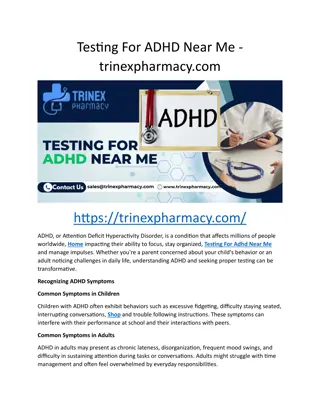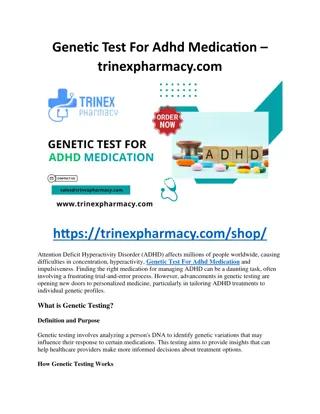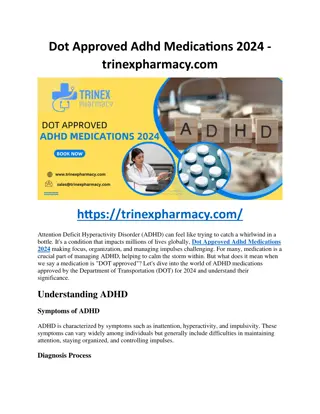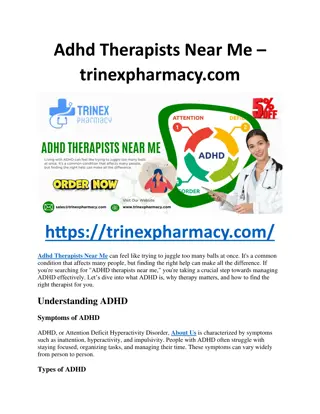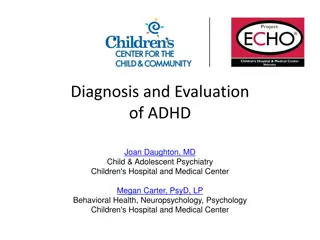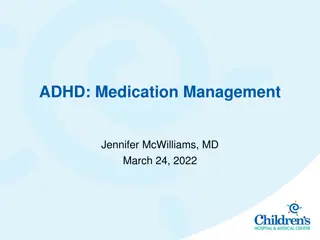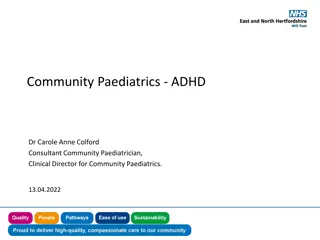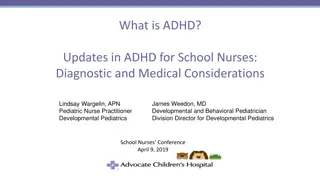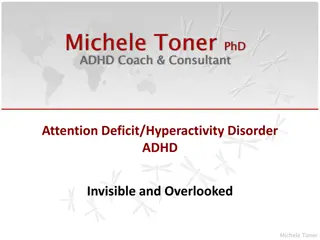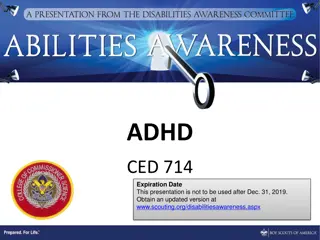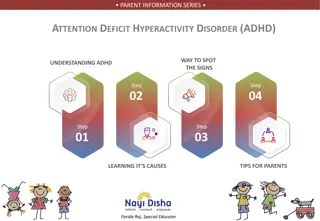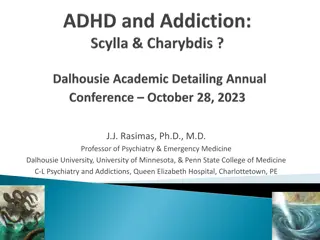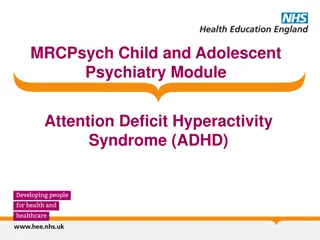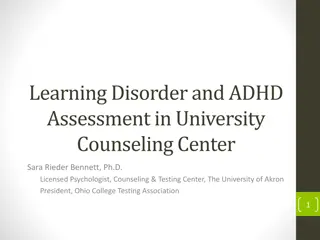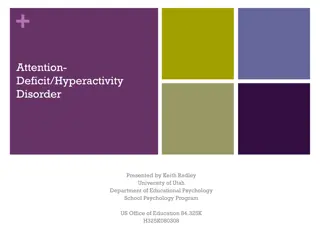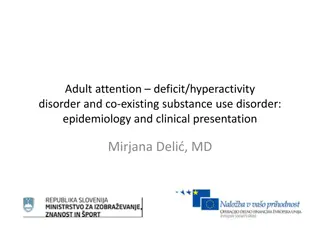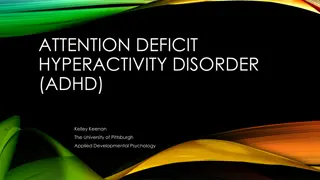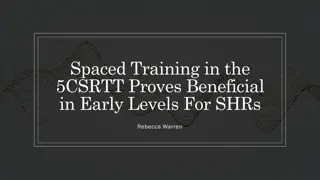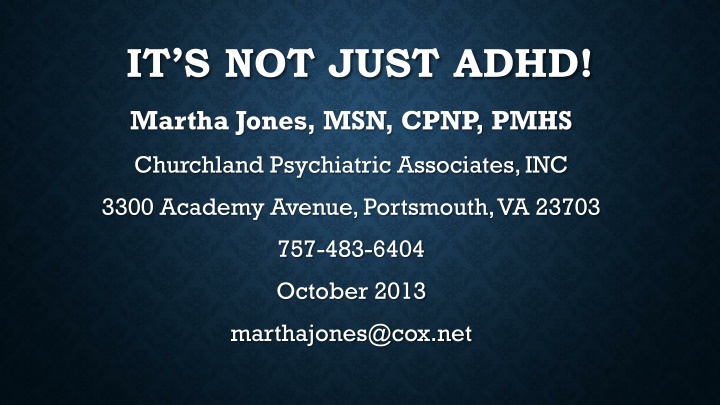
ADHD and Related Disorders: Insights from Martha Jones, CPNP
Explore the complexities of ADHD, its prevalence, historical background, symptoms, and potential misdiagnoses discussed by Martha Jones, a knowledgeable PMHS from Churchland Psychiatric Associates. Gain valuable insights into ADHD behaviors, diagnosis, and treatment options.
Download Presentation

Please find below an Image/Link to download the presentation.
The content on the website is provided AS IS for your information and personal use only. It may not be sold, licensed, or shared on other websites without obtaining consent from the author. If you encounter any issues during the download, it is possible that the publisher has removed the file from their server.
You are allowed to download the files provided on this website for personal or commercial use, subject to the condition that they are used lawfully. All files are the property of their respective owners.
The content on the website is provided AS IS for your information and personal use only. It may not be sold, licensed, or shared on other websites without obtaining consent from the author.
E N D
Presentation Transcript
ITS NOT JUST ADHD! Martha Jones, MSN, CPNP, PMHS Churchland Psychiatric Associates, INC 3300 Academy Avenue, Portsmouth, VA 23703 757-483-6404 October 2013 marthajones@cox.net
OBJECTIVES To identify other diagnosis that can mimic ADHD. To understand behaviors that are more typical for pediatric mood disorders vs. ADHD. To identify symptoms of ADHD (inattentive, hyperactive- impulsive, or combined)
ADHD Prevalence: 4-12% in school aged population. 4:1 boys to girls (hyperactive-impulsive) and 2:1 for inattentive type ADHD has long been recognized to run in families 1stand 2nddegree relatives are at highest risks Concordance rates are higher in full siblings than siblings and in monozygotic than dizygotic twins Research is ongoing on 3 associated genes Neurotransmitter link: insufficient norepinephrine and dopamine in area of frontal lobe controlling ADHD symptoms. New: stimulant medications may have neuro-protective effect Spencer T, Biederman J, Wilens T. Attention-deficit/hyperactivity disorder and comorbidity. Pediatric Clinics North America. 1999;46:915-927, vii. Abstract Akinbami, Liu, Reuben. Attention deficit hyperactivity disorder among children aged 5-17 in the United States. 1998-2000. NCHS Data Brief, 2011, (70), 1-8
ADHD First described systematically by George Still in 1902: defect in moral control 1930-1950 s was labeled: Minimal Brain Damage (MBD) 1950-1960 s MBD recognized most individuals had no evidence of damage so it became hyperkinetic reaction of childhood 1960 s Use of stimulant medications became widespread, although use since 1930 s was recognized to improve symptoms 1970 s Renamed ADD/ADHD
Inattentive Symptoms (bold = DSM V changes): Often fails to give close attention to details or makes careless mistakes in schoolwork, at work, or during other activities (e.g. overlooks or misses details, work that is inaccurate) Often has trouble holding attention on tasks or play activities (e.g. has difficulty remaining focused during lectures, conversations or lengthily conversations) Often does not seem to listen when spoken to directly (eg difficulty managing sequential tasks; difficulty keeping materials and belongings in order; messy, disorganized work; has poor time management; fails to meet deadlines) Often does not follow through on instructions & fails to finish schoolwork, chores, or duties in the workplace (e.g., starts tasks but quickly loses focus and is side-tracked).
Inattentive Symptoms (bold = DSM V changes) Often has trouble; difficulty keeping materials and belongings in order; messy, disorganized work, has poor time management, fails to meet deadlines) Often avoids, dislikes, or is reluctant to do tasks that require mental effort over a long period of time (e.g. schoolwork or homework; for older adolescents and adults, preparing reports, completing forms, reviewing lengthy papers)
Inattentive Symptoms (bold = DSM V changes): Often loses things necessary for tasks and activities (e.g. school materials, pencils, books, tools, wallets, keys, paperwork, eyeglasses, mobile telephones). Is often easily distracted by extraneous stimuli (for older adolescents and adults, may include unrelated thoughts) Is often forgetful in daily activities (e.g. doing chores, running errands for older adolescents and adults, returning calls, paying bills, keeping appointments)
HYPERACTIVITY/IMPULSIVITY Often fidgets with or taps hands or feet, or squirms in seat. Often leaves seat in situations when remaining seated is expected (e.g. leaves his or her place in the classroom, in the office or other workplace, or in other situations that require remaining in place.) Often runs about or climbs in situations where it is not appropriate (adolescents or adults may be limited to feeling restless). Often unable to play or take part in leisure activities quietly. Is often on the go" acting as if "driven by a motor (e.g. is unable to be or uncomfortable being still for extended time, as in restaurants, meetings; may be experienced by other as being restless or difficult to keep up with)
HYPERACTIVITY/IMPULSIVITY Often talks excessively. Often blurts out an answer before a question has been completed (e.g. completes peoples sentences; cannon wait for turn in conversation) Often has trouble waiting his/her turn (e.g. while waiting in line) Often interrupts or intrudes on others (e.g., butts into conversations or games or activities: may start using other people s things without asking or receiving permission: for adolescents and adults, may intrude into or take over what others are doing)
Based on the types of symptoms, three kinds (presentations) of ADHD can occur: Combined Presentation: if enough symptoms of both criteria inattention and hyperactivity-impulsivity were present for the past 6 months Predominantly Inattentive Presentation: if enough symptoms of inattention, but not hyperactivity-impulsivity, were present for the past six months Predominantly Hyperactive-Impulsive Presentation: if enough symptoms of hyperactivity-impulsivity but not inattention were present for the past six months. Because symptoms can change over time, the presentation may change over time as well.
DSM-V Six or more symptoms that have persisted for at least 6 months, to degree that is inconsistent with developmental level that negatively impacts directly on social academic. occupational, activities several symptoms are present in two or more setting, (e.g., at home, school or work; with friends or relatives; in other activities) Several inattentive or hyperactive-impulsive symptoms present prior to age 12 (DSM-IV: had to have symptoms before age 7) For older adolescents and adults (>17) at least 5 symptoms are required
DSM-V Symptoms are not solely a manifestation of oppositional behavior, defiance, hostility or failure to understand tasks or instructions. Allows a comorbid diagnosis with autism spectrum disorder The symptoms do not happen only during the course of schizophrenia or another psychotic disorder.
THE SYMPTOMS ARE NOT BETTER EXPLAINED BY ANOTHER MENTAL DISORDER (E.G.): Anxiety disorders Disruptive mood dysregulation disorder (new) Depressive disorders Dissociative Disorder Bipolar disorder Personality Disorder Oppositional defiant disorder Substance abuse disorders Intermittent explosive disorder Psychotic disorders Autism Reactive attachment disorder
THE SYMPTOMS ARE NOT BETTER EXPLAINED BY Other neurodevelopmental disorders Intellectual disability Medication-induced symptoms of ADHD Neurocognitive disorders Sleep disorders Family stress Chronic illness Nutritional status and other barriers to good health
DIAGNOSIS CHALLENGES DSM criteria also describes NORMAL kids! No physical, imaging, or lab markers PE does not rule in/out diagnosis but can rule out other causes Public Awareness with misinformation Comorbidity greatly influences presentation, diagnosis, and prognosis; complicates treatment
MENTAL HEALTH (MH) CHILD/ADOLESCENT USA Approximately 12 million <18 have mental disorders. Mental health problems affect 1 in 5 young people at any given time. An estimated 2/3 w/ MH problems are not receiving help they need. < 1/3 of children < 18 w/serious MH issues receive any MH services. Up to 1 in every 33 children may be depressed. Depression in adolescents may be as high as 1 in 8. Suicide is the 3rd leading cause of death for ages 15- to 24 & the 6th leading cause of death for ages 5- to 15.
MENTAL HEALTH (MH) CHILD/ADOLESCENTS Schizophrenia is rare in children under age 12, but it occurs in about 3 of every 1,000 adolescents. Between 118,700 and 186,600 youths in the juvenile justice system have at least one mental illness. Of the 100,000 teenagers in juvenile detention, an estimated 60 % have behavioral, cognitive, or emotional issues.
ADHD PSYCHIATRIC MORBIDITY Children with severe ADHD symptoms have a higher likelihood of developing other psychiatric disorders. When ADHD is comorbid with another psychiatric disorder, it is often the first disorder to develop. Epidemiologic studies suggest comorbidity rates of between 50% and 90% with other psychiatric disorders. 45% of children with ADHD have 1 comorbid condition 30% have 2 comorbid conditions 10% have 3 comorbid conditions Spencer T, Biederman J, Wilens T. Attention-deficit/hyperactivity disorder and comorbidity. Pediatric Clinics North America. 1999;46:915-927, vii. Abstract
PSYCHIATRIC COMORBIDITY (THAT I AM GOING TO DISCUSS IN MORE DETAIL) Anxiety Bipolar disorder (BPD)/Mood Disorders Conduct disorder (CD) Depression Oppositional defiant disorder (ODD) Tourette s Syndrome Michielsen M, Comijs HC, Semeijn EJ, et al. The comorbidity of anxiety and depressive symptoms in older adults with attention-deficit/hyperactivity disorder: A longitudinal study. J Affect Disord. 2013;148:220-227.
COMORBID VS. MIMICKING SYMPTOMS Developmental Disorders Learning disability Reading, math, etc. Memory deficits, especially working memory Processing speed deficits Executive Dysfunction Handwriting problems and fine-motor control problem Motor Development Deficits/Developmental Coordination Disorder/Dyspraxia Language Deficits
COMORBID VS. MIMICKING SYMPTOMS Developmental Disorders (continued) Cognitive deficits (MR) Impaired Adaptive Functioning Syndromes/genetic disorders: i.e. fragile x, fetal alcohol syndrome Sensory Impairments Giftedness IQ (not a disorder but can present with inattention for a different reason)
COMORBID VS. MIMIC SYMPTOMS Psychosocial issues Family discord/Abuse Stress Deaths in family or of friends Environmental SES, violence in home or neighborhood, multiple school moves, many children are hungry, etc Parents with ADHD and/or other mental illness
COMORBID VS. MIMIC SYMPTOMS Medical Enuresis (bedwetting) Sleep Apnea Narcolepsy Circadian rhythm disorders Sleep hygiene/patterns up to 56% of children w/ ADHD have problems falling asleep (compared to 23% of normal children). typically have higher resistance to going to bed. up to 39% show problems of night time awakening. dysfunctional sleep habits (i.e. no bedtime, cell phone/texting) fewer total hours of sleep impact school functioning.
COMORBID VS. MIMIC SYMPTOMS Medical History of head trauma: i.e. TBI Prematurity: up to 10% or greater risk depending on birth weight, weeks born premature, IVH/other brain damage, and/or history of exposure drugs/alcohol in uterio Other medications/side effects phenobarbital, dilantin, some asthma/cold medications (i.e. bronchodilators, isoniazid, neuroleptics Hypo/hyper thyroid, RTH (Resistance to Thyroid Hormone) Iron deficiency Hearing or vision issues
COMORBID VS. MIMIC SYMPTOMS Medical Seizure disorders: attention lapses caused by absence seizures, frontal lobe epilepsy, etc. Zhang, et al. evaluated children with frontal lobe epilepsy for the prevalence of ADHD: 89.4% of the children with an abnormal EEG had coexisting ADHD compared with only 25% of children with normal EEG readings. Concluded that frontal lobe epilepsy is strongly linked with the occurrence of ADHD, and this occurrence is even greater for individuals with an abnormal EEG. Zhang DQ, Li FH, Zhu XB, Sun RP. Clinical observations on attention-deficit hyperactivity disorder (ADHD) in children with frontal lobe epilepsy. J Child Neurol. 2012 Dec 26.
PSYCHIATRIC COMORBIDITY: ANXIETY 25-40% comorbidity Worry or a persistent feeling of anxiety, irritability, inability to relax, being hyperalert, low tolerance for stress, difficulty paying attention. PTSD (flashbacks) OCD: attention lapses caused by obsessive thoughts or silent compulsive rituals; Adjustment Disorder Generalized anxiety Performance anxiety Anxiety can be comorbid or just mimic ADHD Michielsen M, Comijs HC, Semeijn EJ, et al. The comorbidity of anxiety and depressive symptoms in older adults with attention-deficit/hyperactivity disorder: A longitudinal study. J Affect Disord. 2013;148:220-227.
PSYCHIATRIC COMORBIDITY: ANXIETY Generalized anxiety disorder (GAD) is the most prevalent, followed by social phobia and separation anxiety disorder (you can have > 1) Anxiety in ADHD may inhibit impulsivity (less impulsivity but more inattention) Children with anxiety are often preoccupied with fears, which impair their ability to focus For anxious children who do not have ADHD, when anxiety improves, their attention often improves. Children w/ADHD & anxiety will continue to struggle with inattention even in the absence of anxiety. Sometimes treating ADHD it self may improve anxiety
PSYCHIATRIC COMORBIDITY: BIPOLAR Estimated rates of BPD of 10% to 22% in children w/ ADHD Rates of ADHD ranging from 57% to 98% in children with BPD Differentiating can be difficult because of symptom overlap Grandiosity, elated mood, racing thoughts, hypersexuality, and less need for sleep are more specific to BPD. Patients with BD and ADHD: higher rates of current mixed episodes, lower rates of mania, greater impairment overall, and higher levels of depression. (Johnson, et al , 2009) Spencer T, Biederman J, Wilens T. Attention-deficit/hyperactivity disorder and comorbidity. Pediatric Clinics North America. 1999;46:915-927, vii. Abstract
PSYCHIATRIC COMORBIDITY: BIPOLAR Every child with significant mood liability, irritability, and uncontrolled anger/aggression should be carefully assessed for the possibility of BPD. Childhood-onset BPD tends to be chronic and continuous rather than episodic and acute up to 85 exhibit rapid cycling throughout the day. Adolescents with comorbid mood disorders and ADHD are at increased risk for suicide attempts with the highest risk during manic episodes.
CLUES/STRATEGIES Effects of stimulants wane despite increasing doses. Behaviors initially markedly worse at home vs. at school (ADHD tends to cross all domains). Recommendation is to always treat mood/bipolar symptoms first. If the ADHD symptoms persist/impair functioning, then treat the ADHD. Stimulant treatment may aggravate manic symptoms in some patients or cause hallucinations.
CLUES/STRATEGIES First degree relative with bipolar increases relative risk about 40% With positive family history of mood/bipolar disorder or suspicion (i.e. no one in my family has any mental disorders however .half the family has been incarcerated for drug & alcohol offences) Do not treat depression or anxiety with SSRIs (also Strattera): can cause manic reaction in child with underlying predisposition for mood disorder.
MANIC SYMPTOMS Severe mood changes:extremely irritable or overly silly and elated Overly-inflated self-esteem,grandiosity Increased energy Decreased need for sleep, Increased talking,talks too much,too fast;changes topics too quickly Distractibility,attention moves constantly from one thing to the next Hypersexuality,sexual thoughts,feelings,or behaviors Increased goal-directed activity or physical agitation Excessive involvement in risky behaviors or activities Psychosis Suicidal ideation
DEPRESSIVE SYMPTOMS Persistent sad or irritable mood Loss of interest in activities once enjoyed Significant change in appetite or body weight Difficulty sleeping or oversleeping Physical agitation or slowing Loss of energy Feelings of worthlessness or inappropriate guilt Difficulty concentrating Recurrent thoughts of death or suicide
PSYCHIATRIC COMORBIDITY CONDUCT D/O Comorbid CD/ADHD associated with; more aggression and delinquency greater academic underachievement greater risk of substance abuse increased social maladjustment lower self-esteem. The extreme, irritable aggression of BPD can lead to diagnose CD when, in fact, the child's aggression is driven by mood dysregulation of an underlying BPD.
DSM-V CONDUCT DISORDER A repetitive & persistent pattern of behavior in which the basic rights of others or major age-appropriate societal norms or rules are violated, presence of > 3 of 15 criteria present in the past 6 months Often bullies, threatens, or intimidates others Often initiates physical fights Has used a weapon that can cause serious physical harm to others Has been physically cruel to people Has been physically cruel to animals Has stolen while confronting a victim (mugging, purse snatching, extortion, armed robbery)
DSM-V CONDUCT DISORDER Has forced someone into sexual activity Has deliberately engaged in fire setting w/intention to cause serious harm Has deliberately destroyed others property (other than by fire setting) Has broken into someone else s home, building or car Often lies to obtain goods, favors or to avoid obligations (i.e. cons others) Often stays out at night despite parental prohibitions, prior to 13 yrs Has run away from home overnight at least twice while living in the parental or parental surrogate home , or one without returning for a lengthily period Is often truant from school, beginning before age 13 years
PSYCHIATRIC COMORBIDITY DEPRESSION Depression with ADHD: 20% to 40% Some symptoms may develop as a result of the social, academic, and other impairment resulting from ADHD 10 and 30% children with ADHD are likely to show evidence of depression, usually major depressive or dysthymic disorder Between 5% and 40% of children & teens with ADHD meet criteria for MD (major depressive disorder) MD in children with ADHD is often recurrent and quite impairing. Prevalence of depression increases significantly in adolescence. Michielsen M, Comijs HC, Semeijn EJ, et al. The comorbidity of anxiety and depressive symptoms in older adults with attention-deficit/hyperactivity disorder: A longitudinal study. J Affect Disord. 2013;148:220-227.(Johnson, et al, 2009).
PSYCHIATRIC COMORBIDITY: ODD Oppositional defiant disorder (ODD): up to 50% of children w/ADHD Is one of the most common comorbid disorders with ADHD ODD is 2- to 3 fold more common than CD ODD usually starts before age eight, but no later than early adolescence. Symptoms may occur most often with people the individual knows well, such as family members or a regular care provider. These behaviors are present beyond what are expected for the child s age, and result in significant difficulties in school, at home, and/or with peers. (Johnson, Alvarez & Johnson, 2009)
PSYCHIATRIC COMORBIDITY: ODD Examples of ODD behaviors include: Losing one s temper a lot Arguing with adults or refusing to comply with adults rules or requests Often getting angry or being resentful or vindictive Deliberately annoying others; easily becoming annoyed with others Often blaming other people for one s own mistakes or misbehavior
PSYCHIATRIC COMORBIDITY TOURETTE SYNDROME (TS) Between 40 and 50% with TS also show features of ADHD. Approximately 7% of children with ADHD develop TS. Onset of tic disorders in general is later than that of ADHD. Medications do not CAUSE tics but can unmask with underlying predisposition. Tics do not cause harm (i.e. brain damage) but can cause discomfort and demoralization if source of teasing or bullying. Tics come and go and tend to increase with stress. Typically children can not suppress tics please be alert for teachers who expect this.
STIMULANTS MAY PROVIDE NEUROPROTECTIVE EFFECTS Previous MRI studies of children with ADHD show cortical thinning Magnetic resonance imaging -based neuroimaging case-control and placebo controlled studies examined patients with ADHD on and off stimulants. MRIs images of cortical thickness of children with ADHD who received stimulant medication were compared to images from age-matched children with ADHD not receiving medication and typically developing children. The cortical thickness in the group of youth with ADHD who received psychostimulants was similar to the typically developing youth. Children not receiving medications showed more rapid thinning. Therapeutic oral doses of stimulants decrease alterations in brain structure and function in subjects with ADHD relative to unmediated subjects and controls. Timothy Wilens, MD,


